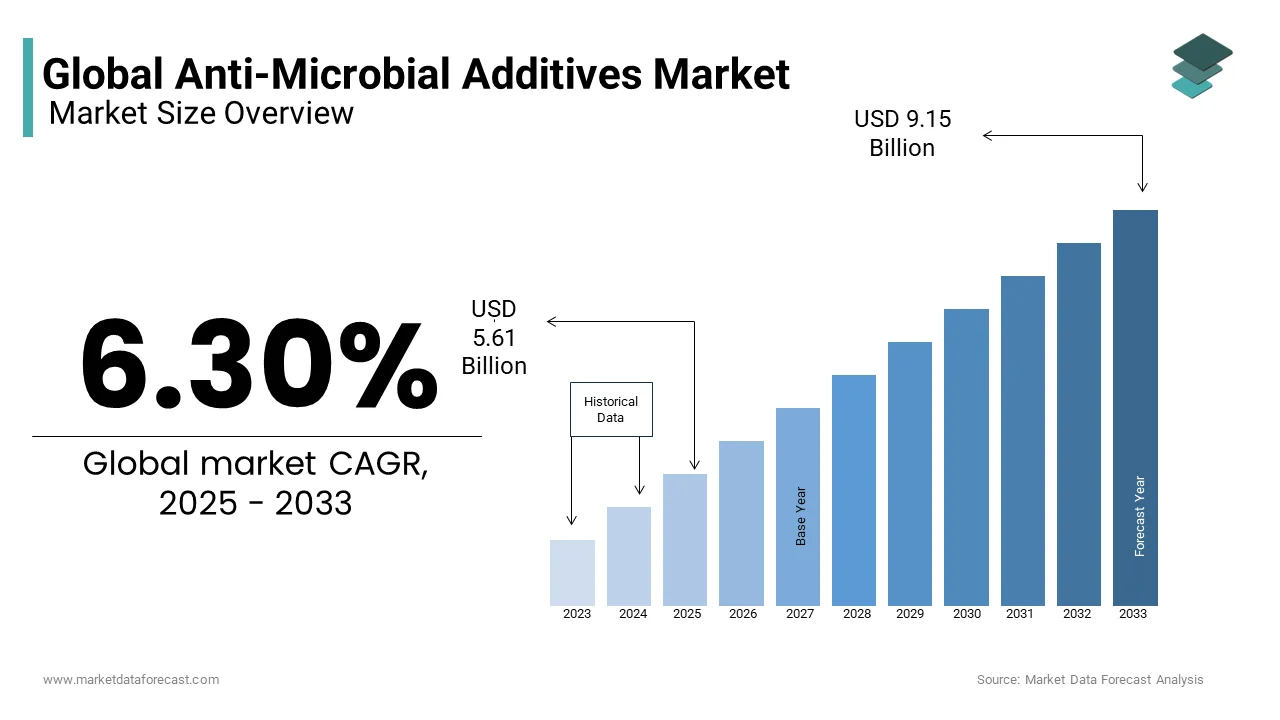Global Anti Microbial Additives Market Size, Share, Trends & Growth Forecast Report, Segmented By Type (Inorganic (Silver, Copper, Zinc), Organic (OBPA, DCOIT), Application (Plastic, Paints & Coatings, Pulp & Paper), End-User (Healthcare, Packaging, Food & Beverage, Construction), By Region (North America, Europe, Asia Pacific, Latin America, and Middle East and Africa), Industry Analysis From (2025 to 2033)
Global Anti-Microbial Additives Market Size
The global anti-microbial additives market was valued at USD 5.28 billion in 2024 and is anticipated to reach USD 5.61 billion in 2025 from USD 9.15 billion by 2033, growing at a CAGR of 6.30% during the forecast period from 2025 to 2033.

The market is showcasing evident potential in the mentioned forecasting period. Antimicrobial additives control microbes via many different means and are extremely diverse. When used in the manufacturing of products they create surfaces and materials inhospitable to microbes such as bacteria and mold. The properties of silver are non-toxicity, high thermal stability, and environmental friendliness which boost the global anti-microbial additives market. Antimicrobial additives are chemical ingredients that prevent bacterial, fungal, and algal growth in materials that are exposed to high levels of ultraviolet radiation, moisture, and unsanitary conditions. These additives are primarily used in applications such as plastics, papers, paints & coatings, textiles, inks, rubber, and fabric care to inhibit the growth of unwanted microorganisms and increase the longevity of the substrate.
MARKET DRIVERS AND RESTRAINTS
The antimicrobial additives market is driven by the rapid growth of the healthcare and packaging industries in the Asia-Pacific region. In recent times, China, India, Japan, and South Korea have observed a high demand for antimicrobial additives, mainly due to the growing urbanization, aging population, and increasing lifestyle diseases. This is fuelling the growth of the antimicrobial additives market in this region. Properties like non-toxicity, environmental friendliness, flammability, sustainability, and high thermal stability of silver antimicrobial additives contribute to the growth of the antimicrobial additives market.
The major factor restraining the growth of the antimicrobial additives market is the high cost o0f raw materials and stringent regulations. The basic raw materials used in the manufacturing of antimicrobial additives products are silver, copper, and zinc. The high price of silver antimicrobials restricts their use in various products, particularly in the developing regions of Asia-Pacific and South America. These issues restrain the growth of the Anti-Microbial Additives Market. The Anti-Microbial additives market is broadly categorized into the Inorganic Anti-Microbial additives market (Silver, Copper, and Zinc) and the organic Anti-Microbial Additives Market (OBPA, DCOIT).
REPORT COVERAGE
|
REPORT METRIC |
DETAILS |
|
Market Size Available |
2024 to 2033 |
|
Base Year |
2024 |
|
Forecast Period |
2025 to 2033 |
|
CAGR |
6.30% |
|
Segments Covered |
By Application, End-User, And Region |
|
Various Analyses Covered |
Global, Regional & Country Level Analysis, Segment-Level Analysis, DROC, PESTLE Analysis, Porter’s Five Forces Analysis, Competitive Landscape, Analyst Overview on Investment Opportunities |
|
Regions Covered |
North America, Europe, APAC, Latin America, Middle East & Africa |
|
Market Leaders Profiled |
BASF SE, The Dow Chemical Company, Clariant AG, A. Schulman, Inc., Polyone Corporation, Sanitized AG, Microban International, Biocote Limited, King Plastic Corporation, and Steritouch Ltd. |
SEGMENT ANALYSIS
By End-User Insights
Silver-based antimicrobial additives accounted for the highest revenue of the overall market and are projected to witness a high growth rate during the forecast period.
REGIONAL ANALYSIS
The anti-microbial additives market was dominated by Asia-Pacific, with an overall market share of over 30% globally. Asia-Pacific was followed by North America and Europe. Asia Pacific is predicted to grow at a rapid pace in the coming few years.
KEY MARKET PLAYERS
Some of the major companies dominating the Anti-Microbial Additives Market by their products and services, include BASF SE, The Dow Chemical Company, Clariant AG, A. Schulman, Inc., PolyOne Corporation, Sanitized AG, Microban International, Biocote Limited, King Plastic Corporation, and Steritouch Ltd.
MARKET SEGMENTATION
This research report on the global anti-microbial additives market is segmented and sub-segmented into the following categories.
By Application
- Plastics
- Paint and Coating
- Pulp and Paper
By End-User
- Healthcare
- Packaging
- Food and Beverages
- Construction
By Region
- North America
- Europe
- Asia-Pacific
- Latin America
- Middle East And Africa
Frequently Asked Questions
What are antimicrobial additives, and where are they used?
Antimicrobial additives are chemical agents incorporated into materials (like plastics, paints, textiles, and coatings) to inhibit the growth of bacteria, mold, fungi, and viruses—used widely in healthcare, packaging, construction, and consumer goods.
What’s driving growth in the global antimicrobial additives market?
Rising awareness of hygiene, increased demand for antimicrobial surfaces post-COVID, growth in healthcare infrastructure, and regulatory pressure to ensure product safety in food contact and medical applications are fueling global market expansion.
What types of antimicrobial additives are most commonly used?
Key types include inorganic additives like silver, copper, and zinc (known for durability and heat resistance), and organic additives such as triclosan and quaternary ammonium compounds—each suited for specific end-use industries.
What challenges does the antimicrobial additives market face?
Challenges include regulatory scrutiny over certain chemical agents (like triclosan), environmental concerns, higher production costs, and balancing antimicrobial effectiveness with product safety and recyclability.
How is the future of the antimicrobial additives market evolving?
The future is shaped by bio-based antimicrobial innovations, smart surface materials, integration with IoT for self-monitoring hygiene, and expanding applications in public infrastructure, packaging, and smart textiles.
Related Reports
Access the study in MULTIPLE FORMATS
Purchase options starting from $ 2500
Didn’t find what you’re looking for?
TALK TO OUR ANALYST TEAM
Need something within your budget?
NO WORRIES! WE GOT YOU COVERED!
Call us on: +1 888 702 9696 (U.S Toll Free)
Write to us: [email protected]